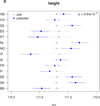Population genetic differentiation of height and body mass index across Europe
- PMID: 26366552
- PMCID: PMC4984852
- DOI: 10.1038/ng.3401
Population genetic differentiation of height and body mass index across Europe
Abstract
Across-nation differences in the mean values for complex traits are common, but the reasons for these differences are unknown. Here we find that many independent loci contribute to population genetic differences in height and body mass index (BMI) in 9,416 individuals across 14 European countries. Using discovery data on over 250,000 individuals and unbiased effect size estimates from 17,500 sibling pairs, we estimate that 24% (95% credible interval (CI) = 9%, 41%) and 8% (95% CI = 4%, 16%) of the captured additive genetic variance for height and BMI, respectively, reflect population genetic differences. Population genetic divergence differed significantly from that in a null model (height, P < 3.94 × 10(-8); BMI, P < 5.95 × 10(-4)), and we find an among-population genetic correlation for tall and slender individuals (r = -0.80, 95% CI = -0.95, -0.60), consistent with correlated selection for both phenotypes. Observed differences in height among populations reflected the predicted genetic means (r = 0.51; P < 0.001), but environmental differences across Europe masked genetic differentiation for BMI (P < 0.58).
Conflict of interest statement
The authors declare no conflicts of interest pertaining to this study.
Figures






References
-
- Moussavi S, et al. Depression, chronic diseases, and decrements in health: results from the World Health Surveys. Lancet. 2007;370:851–858. - PubMed
-
- Wild S, Roglic G, Green A, Sicree R, King H. Global Prevalence of Diabetes: Estimates for the year 2000 and projections for 2030. Diabetes Care. 2004;27:1047–1053. - PubMed
-
- Dye C. Global Burden of Tuberculosis: Estimated Incidence, Prevalence, and Mortality by Country. JAMA. 1999;282:677. - PubMed
-
- Lopez AD, Mathers CD, Ezzati M, Jamison DT, Murray CJL. Global and regional burden of disease and risk factors, 2001: systematic analysis of population health data. Lancet. 2006;367:1747–1757. - PubMed
-
- Wang H, et al. Age-specific and sex-specific mortality in 187 countries, 1970–2010: a systematic analysis for the Global Burden of Disease Study 2010. Lancet. 2012;380:2071–2094. - PubMed
Publication types
MeSH terms
Grants and funding
- RC2 MH089951/MH/NIMH NIH HHS/United States
- R01 AA007535/AA/NIAAA NIH HHS/United States
- DA12854/DA/NIDA NIH HHS/United States
- 1RC2-MH089995-01/MH/NIMH NIH HHS/United States
- N01 HC025195/HL/NHLBI NIH HHS/United States
- MC_UU_12013/1/MRC_/Medical Research Council/United Kingdom
- R01 DA012854/DA/NIDA NIH HHS/United States
- AA014041/AA/NIAAA NIH HHS/United States
- WT_/Wellcome Trust/United Kingdom
- T32 HL007055/HL/NHLBI NIH HHS/United States
- AA13326/AA/NIAAA NIH HHS/United States
- R01 AA013320/AA/NIAAA NIH HHS/United States
- R01 AA014041/AA/NIAAA NIH HHS/United States
- 1RC2-MH089951-01/MH/NIMH NIH HHS/United States
- AA13320/AA/NIAAA NIH HHS/United States
- U01 AG009740/AG/NIA NIH HHS/United States
- RC2 MH089995/MH/NIMH NIH HHS/United States
- N02 HL064278/HL/NHLBI NIH HHS/United States
- AA13321/AA/NIAAA NIH HHS/United States
- AA10248/AA/NIAAA NIH HHS/United States
- R01 HD042157/HD/NICHD NIH HHS/United States
- R01 AA013326/AA/NIAAA NIH HHS/United States
- R56 DA012854/DA/NIDA NIH HHS/United States
- MC_UU_12015/1/MRC_/Medical Research Council/United Kingdom
- R01 AA013321/AA/NIAAA NIH HHS/United States
- U01 DK066134/DK/NIDDK NIH HHS/United States
- U24-MH068457-06/MH/NIMH NIH HHS/United States
- MC_U106179471/MRC_/Medical Research Council/United Kingdom
- U01-AG09740/AG/NIA NIH HHS/United States
- U24 MH068457/MH/NIMH NIH HHS/United States
LinkOut - more resources
Full Text Sources
Other Literature Sources

